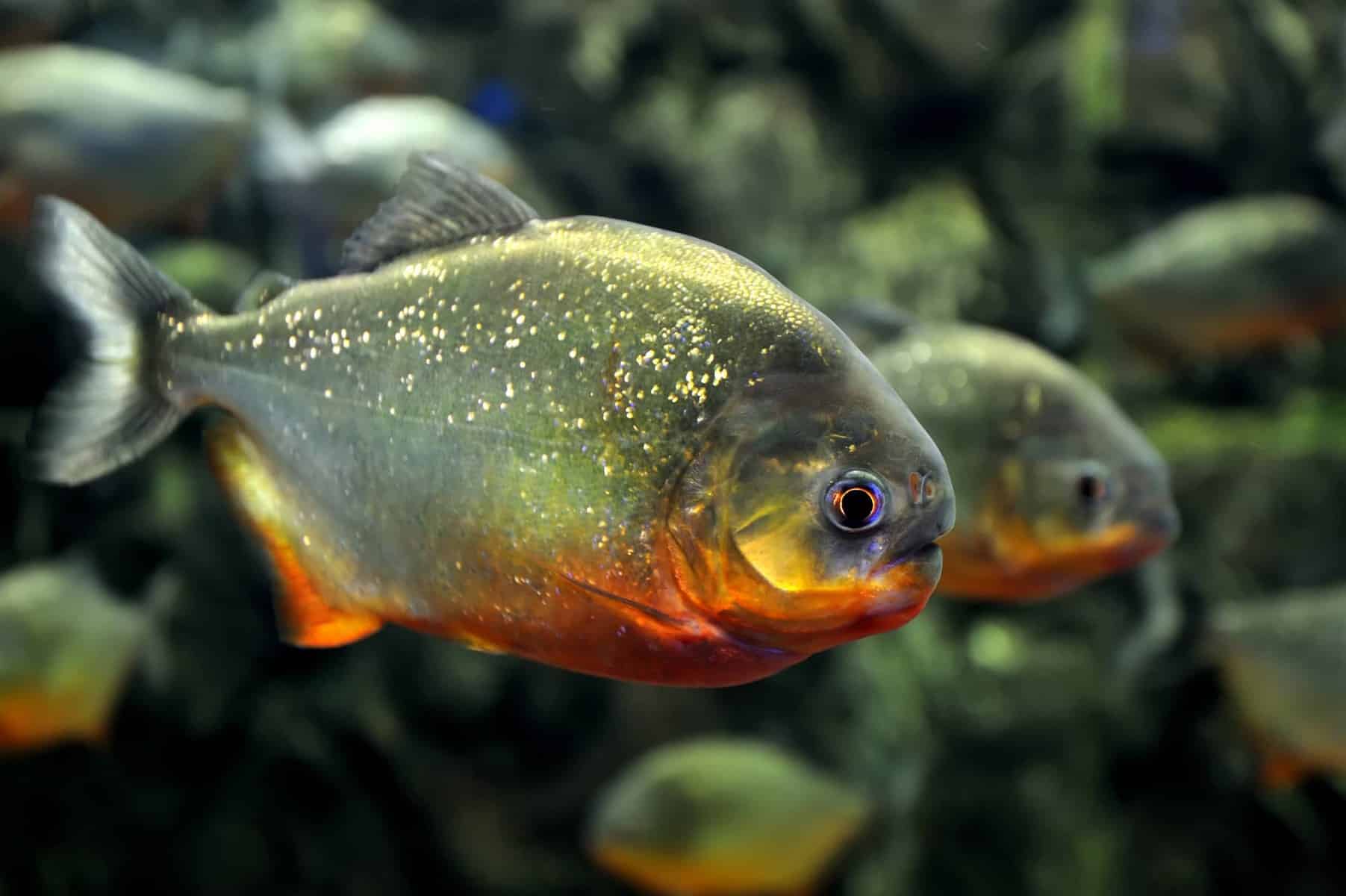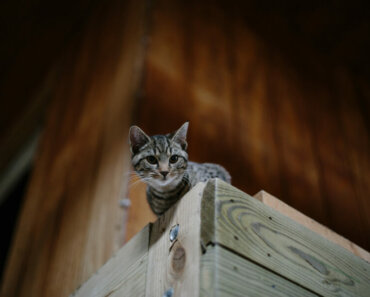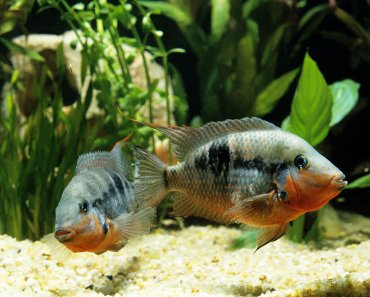We’ve all seen the piranha-infested waters portrayed in horror movies, but how much of that is actually true? And did you know that you can keep a red-bellied piranha in your home aquarium with the proper care?
Unfortunately, wild piranhas get a bad rap as vicious fish. On the contrary, they’re one of the coolest fish species you can own and are even cooler in their natural habitats. We are here to help stop the spread of lies about this incredible species.
Keep reading to find out everything you need to know about red-bellied piranhas and keeping them in your freshwater aquarium, and to discover if the legends are true!
Name
The red-bellied piranha (Pygocentrus nattereri), sometimes referred to as the red piranha, is one of the most recognizable distinct species of piranha. As their name suggests, they have an identifiable red stomach that makes them stand out in their natural murky water habitats.
Pacus are a larger species in the same family (Serrasalmidae) as piranhas and share a similar appearance.
Natural habitat
Piranhas are one of the most well-known species originating from the Amazon rainforest in South America. These fish are widespread throughout the continent in regions with low elevation and freshwater reserves, like coastal rivers, including the Essequibo River in Guyana. There, they travel in shoals, though juveniles form tighter groups than adults.
Their teeth are valuable tools for many native people, and their meat is a common food.
You should note that it is illegal to sell, possess, or transport piranhas in the Philippines and several states in America.
Has a piranha ever killed a person?
Piranhas are one of the most feared fish in the world, though this worry is largely irrational.
Many stories of terrifying, flesh-eating fishes originate from the Amazon River basin, where family members go into the water and never come out. These stories might be accompanied by witnessing a feeding frenzy of sorts by hundreds of adult piranhas with splashing, bloodied water, and shredded skin.
Though there have been multiple accounts of humans being critically and fatally injured by these notorious freshwater fishes through accidental biting, their rare aggression can usually be linked to increased numbers, food shortages, and breeding periods.
The truth is that supposed voracious packs of piranhas will rarely attack an unharmed living creature. Most events have shown piranha injury post mortem with another cause of death, like drowning, happening first.
That said, always use caution when entering natural waters where piranhas are known to be present and adhere to any stated safety regulations.
Identification
Thanks to mainstream media, most people know how a piranha generally looks. This can be troublesome for other similar-looking Amazonian species, like pacu, that aren’t aggressive fish and won’t cause any harm.
Red-bellied piranhas can grow to about a foot long (30.5 cm) and weigh about 4 pounds (1.8 kg). These adult fish are reflective silver with red along the stomach, cheeks, and under the chin. Their rounded mouth and chin allow for the best force distribution and shearing power to tear flesh from bone with their incredible set of triangular teeth.
The coin-sized juvenile red-bellied piranhas have not yet developed their signature red stomach. Instead, they are silver with dark spots across their bodies.
Unfortunately, there are few ways to tell an adult red-bellied piranha apart from a harmless pacu from far away. Since red-bellied piranhas are omnivores and pacu are mainly herbivores, there is a big difference in tooth structure; pacu have very short rounded teeth while piranhas have long, sharp teeth.
Pacu are a larger fish species that can grow to nearly 4 feet (121.9 cm), and these timid fish live a primarily solitary life.
Red-bellied piranha tank requirements
Red-bellied piranhas need larger tanks, but not necessarily a complex tank setup. In fact, these aquarium fish do best with plenty of swimming space and a few structures that they can hide around.
This piranha species is known for being very skittish, so don’t just purchase a single specimen. It is essential to keep them in groups of at least four or more. Because they can grow so large, the bare minimum tank size for a school of adult piranhas this large is 125 gallons (473.2 L).
Unfortunately, many hobbyists think that they can keep a large group of juvenile piranha in a small aquarium environment and give them away or upgrade to larger aquaria when necessary. You should always stock for the community tank you already have to avoid problems in the future.
These fish will also need high levels of filtration as part of their aquarium care. It is recommended to have an external filter rated for water flow 2-3 times the size of the aquarium as piranhas are such messy feeders. If you’re building an Amazonian biotope aquarium, lighting should be minimal, and water should be stained with tannins to best recreate the blackwater conditions found throughout the Amazon.
You can naturally introduce tannins into the tank through large pieces of driftwood or submerged wood root. A couple of large pieces placed throughout the aquarium in standard aquarium gravel or sand should give your piranhas enough space to swim and places to hide.
Live aquatic plants may also be added as aquarium decor according to your personal taste, but expect them to be regularly nipped at and uprooted. It is best to go with very hardy and fast-growing species, like pothos (Epipremnum aureum). Many hobbyists choose to skip aquarium plants altogether as they can be more work than they’re worth.
It should also be noted that piranhas are very capable of chewing through electrical cords. Any electrical cords from lights, filters, airlines, or other aquarium equipment should be removed from the tank walls or guarded with aquarium-specific wire protection.
Are piranhas difficult to care for?
Red-bellied piranhas are one of the easiest species of piranha to care for. That said, in comparison to other tropical fish, they’re not as simple as keeping a guppy.
The main concerns with the care and maintenance of piranhas are space, aggression, and feeding. Red-bellied piranhas need a lot of space that most hobbyists just aren’t ready to provide; it can be very tempting to overstock a spacious tank with juvenile piranhas, but you always need to keep their full adult size in mind.
Though shoaling fish, they don’t always get along with each other. Hobbyists need to be able to diffuse aggressive behavior and even rehome fish if things get out of hand.
Feeding can also become expensive over time, and keeping up with tank water quality can be an extra chore that hobbyists aren’t prepared for. Though feedings are one of the best parts of owning a piranha, there’s definitely a lot that needs to go on behind the scenes to keep these fish healthy.
Red-bellied piranha tank mates
The best piranha setup in the aquarium hobby trade is a piranha-only setup. This is mainly due to space requirements and, of course, the real possibility that any fish you try to keep with your piranhas can be eaten (and yes, piranhas may also eat each other!).
As mentioned before, red-bellied piranhas need to be kept in small shoals. When left alone, they become incredibly skittish, and you will hardly ever see your fish, let alone see it exhibit its natural behaviors.
So what can you keep with a red-bellied piranha?
There are a few options, but everything you add should be considered a potential snack; it’s not an if but a when.
Hobbyists have tried many different tank mate combinations with varied results. Some of the most successful combinations have actually been with smaller live-bearing fish, like endlers (Poecilia wingei). The idea is that they are quick enough to escape the piranha, and those that aren’t will quickly get replaced by new fry.
Some aquarium hobbyists have also had luck adding aquatic invertebrates, like shrimp, crabs, and snails, while others have had their piranhas literally chew through the transportation bag to get at their new tank mate.
Red-bellied piranha behavior

Red-bellied piranhas are considered one of the most ferocious wild fish species, but how does that translate into the aquarium?
Honestly, these fish might not live up to your expectations. Though they’re incredible fish that are utterly unique, they might not give you the bloodthirsty horror show that you’re expecting and are really opportunistic generalists.
Instead, these fish are generally calm yet messy feeders. They are active swimmers and will startle if there are unexpected outside lights or noises around the aquarium. They aren’t constantly flashing their teeth, looking for the next thing to scavenge.
However, they are voracious eaters and will go into a frenzy when meaty food enters the water. You should not purchase these fish for just this reason alone, though, as they are an amazing species otherwise.
Are piranhas dangerous?
Yes, piranhas are dangerous. Though it is unlikely, they are very capable of inflicting injury and are largely unpredictable.
It is not recommended to be directly hands-on with your fish. Instead, purchase equipment that allows you to safely keep all body parts outside of the aquarium glass at all times.
If it is absolutely necessary to put your hands in the tank, make sure you don’t have any open cuts and keep your eyes on your fish at all times. Move slowly and do what you need to do as fast as you can.
At first, it might seem that your piranhas naturally shy away from your hand. As they get more comfortable, they will stop hiding when you enter the tank. Every time you do this, you increase the chances of being bitten as your fish no longer see your hand as a threat but now as a danger and a possible meal.
Red-bellied piranha diet
Here is where the fun starts, though we first need to look at these fishes’ natural diet in the wild.
Yes, these fish enjoy a variety of quality meaty foods. But did you know that they’re not exclusive carnivores, but actually omnivores and need to have some greens in their balanced diet, too?
What do piranhas actually eat?
Piranhas eat large amounts of food, and being omnivores means that these fish need to be fed both plant- and animal-based foods.
In the wild these fish have a varied diet and get most of their nutrition from nipping at the fins of other fish, eating other fish and invertebrates whole, or scavenging for various carcasses. However, they also take the opportunity to eat any nuts, fruits, or seeds they happen to come across.
These fish will greatly appreciate live, frozen, and freeze-dried bloodworms, mealworms, and earthworms, along with beef heart, fish fillets, shrimp, and crab.
Though you might want to see your fish chase after other live fish, this is not recommended as it can facilitate parasites and other diseases. You are usually safe to add an aquarium-bought snail now and then; it may even be worthwhile to set up a culture of feeder fish or feeder snails for a healthy population.
Conclusion
Red-bellied piranhas have a bad reputation outside of aquarium circles, but they’re quite possibly one of the coolest species that can be kept in the home aquarium trade.
Overall, the captive maintenance of these fish is easy. But, care needs to be given from the start to ensure they have enough room to grow, that their omnivorous dietary needs are being met, and that water quality is being maintained.
If you have any questions about red-bellied piranhas, another piranha species, or have had experience keeping these ferocious fish in your tank before, don’t hesitate to leave a comment below!


























